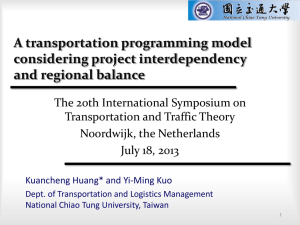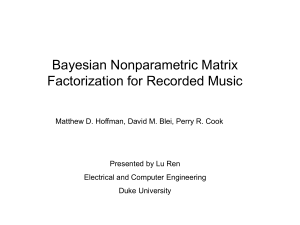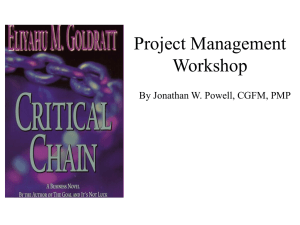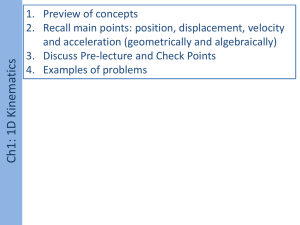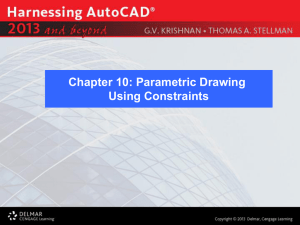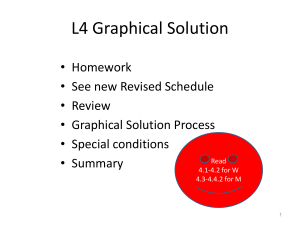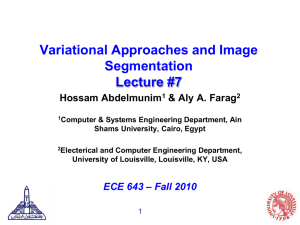Nonholonomic variational systems
advertisement
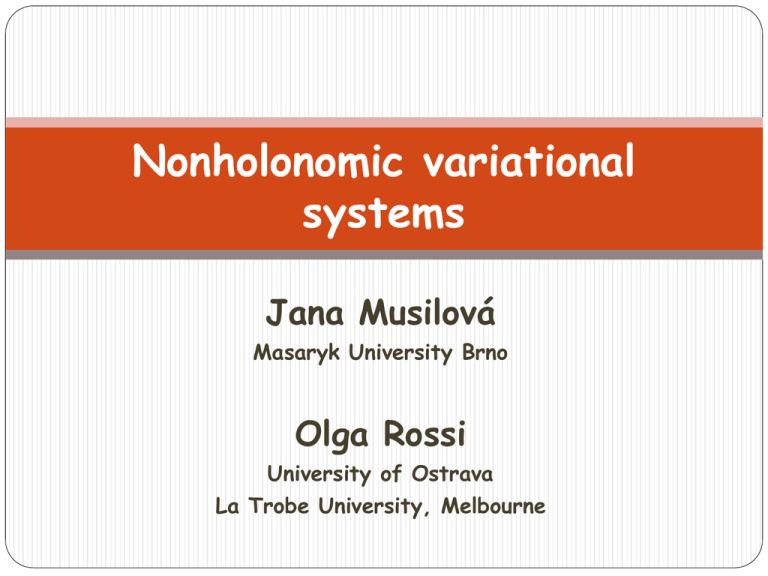
Nonholonomic variational
systems
Jana Musilová
Masaryk University Brno
Olga Rossi
University of Ostrava
La Trobe University, Melbourne
Abstract - I
The inverse variational problem is a natural part of calculus
of variations. There is a question if given equations of
motion arise from a Lagrangian system, or not. This is
completely answered by Helmholtz conditions.
In our presentation we deal with the nonholonomic
mechanics. The inverse problem of the calculus of variations
for second order ODE in the context of nonholonomic
constraints is investigated. Relationships between Chetaev
equations, constrained Euler-Lagrange equations coming
from a nonholonomic variational principle, closed 2-forms on
constraint manifolds, and a corresponding generalization of
Helmholtz conditions are studied.
Abstract – II
It appears that every unconstrained variational system
remains variational under an arbitrary nonholonomic
constraint. On the other hand, the appropriate constraint
can be used for transforming an initially non-variational
system to the constraint variational one. We present
some simple examples.
The approach is based on the geometrical theory of
nonholonomic mechanics on fibred manifolds, first
presented and developed by Olga Rossi.
Outline of the presentation
Setting of the problem
Fibred manifolds, variational systems, Helmholtz
conditions
Nonholonomic structure, reduced equations,
constraint calculus
Nonholonomic variational systems, nonholonomic
Helmholtz conditions
Examples: ballistic motion, damped planar oscillator
Setting of the problem
mechanical system
( t , q , q ), 1 m
nonholonomic constraint f ( t , q , q ) 0, 1 i k , 1 k m 1
i
Chetaev constraint force
i
f
i
F
, rank k
q
q
Chetaev equations
d L
i f
q
dt q
q
f
L
ChE with constraints: system of
i
i
m +k mixed 1st and
2nd order ODE for m components of the system
trajectory c(t) and k Lagrange multipliers μiσ
Fibred manifolds – general
fibred manifold and their jet prolongations
(Y , , X ), : Y X , dim X n , dim Y n m ,
J Y J
r
sections
r 1
Y
J Y Y X
1
: X Y , id X , : X J Y , r id X ,
r
J , J ( t ) ( t , q ( t ), q ( t ),
r
q-forms
r
, q ( r ) ( t ))
horizontal: 0 for every vertical v. field on J Y
r
contact:
J 0 for every sect ion of
r
*
k contact: is ( k 1) contact for every vertic al
canonical decom position : r 1, r h p1
*
p q
Fibred manifolds - notation
used prolongations of (Y , π ,
X)
1
2
J Y (evolution space of the system ), J Y
fibred
coordinates
Y:
(V , ), ( t , q ), (U , ), U (V ), ( t )
1
J Y : (V1 , 1 ), V1 (1,0 ) (V ), 1 ( t , q , q )
1
1
J Y : (V 2 , 2 ), V 2 ( 2 ,0 ) (V ), 2 ( t , q , q , q )
2
contact
bases of
1-forms
J Y : (d t , , d q )
1
J Y : (d t , , , d q )
2
dq q dt, dq q dt
Variational (Lagrangian) system - 1st order
variational
( ) S [ ]
integral
J
1
*
L (t , q , q ) d t
horizontal 1-form
variational derivative
( )
d S [ u ]
du
u 0
1
d
1
u u 0u , ( u , 0u )
1st variational
formula
du
*
J J 1
1
*
u 0
one-param eter group of ( , 0 )
*
L dt
1
0u ( )
J J 1
1
J u
J J 1 d
1
*
L
q
J J 1
1
*
Lepage equivalent o f
Variational system – motion equations
Extremals
stationary sections of the variational integral
d S [ u ]
du
0 J J 1 d 0 fo r every vert ical
1
*
u 0
Euler-Lagrange form
L
E p1 d , E E d t , E
q
d L
dt q
Euler-Lagrange equations
E
J 0, E
2
J 0 J
2
1
*
J
1
d 0, 1 m
Dynamical system – inverse problem
dynamical
E E (t , q , q , q ) d t , 1 m
form
E A ( t , q , q ) B ( t , q , q ) q
associated mechanical system
A d t B d q
F
E p1 , [ ] A d t B d q
equations
of motion
m o d 2 -co n t
J 0
1
*
1 vertical vecto r field o n J Y
main theorem of the inverse problem
1
The dynamical system [α] is variational iff it
contains a closed representative. Then it is unique.
Helmholtz conditions
Helmholtz conditions of variationality
{ B } alt ( , )
A
d B
q
d
t
sym ( , )
0,
A
1 d A
0
2 dt q
q
alt ( , )
B
0,
q alt ( , )
F F ,
F
A
1 A
4 q
q
Lagrangian (e.g. Vainberg-Tonti)
1
L q
0
0
E ( t , uq , uq , uq ) d u
Nonholonomic structure - notations
constraint
submanifold
canonical
embedding
canonical
distribution
constrained
mechanical
system
Q : {( t , q , q ) J Y | q
1
m k i
g ( t , q , q )} J Y
i
l
1
1 l m k , codim Q k
: Q (t , q , q ) (t , q , q , q
l
l
C span { },
0
C
i
i
*
m k i
m k i
( t , q , q )) J Y
g
i
q
l
1
l
subbundle of T Q , codim C k
physics:
[ ] [ ], F d t
geom etry: [ Q ]
*
m od 2 cont, I ( C )
0
[ Q ] [ Al d t B ls d q ]
l
l
Constraint calculus - I
constraint derivative
F
F
F
F
m k i
l
d c F (t , q , q )
dt dq
d
q
d
q
mk i
l
t
q
q
q
l
*
F
F
l F
i
q
g
l
m k i
t
q
q
i
F
F g l F
F
l
i
d
t
d
q
l
m k i
l
l
m k i
q
q
q
q
q
constraint derivative operators
d c
dt
t
q
l
q
l
g
i
q
m k i
,
c
q
l
q
l
g
i
q q
l
m k i
,
c
q
l
q
l
i
i
d c c
d c d c
g
l
l c
l
g q
,
q
,
q
l
m k i
l
l
t t
q q
dt t
q
dt dt
q
c
Constraint calculus – II
Euler-Lagrange constraint operators
l
c
q
l
d c
dt q
l
, l l q
s
2
q q
l
s
Chetaev vector fields
Z Z
0
c
t
Z
l
c
q
l
Z
l
q
l
Z
0
t
Z
l
q
i
0 i
g
l
0 l
l
Z
g
(
Z
Z
q
)
Z
,
l
m k i
l
q q
q
c c
C span , l , l
t q q
l
com ponents defined on Q
, dim C 2 m 2 k 1
Reduced equations
path of [αQ]
(trajectory)
in coordinates
J Q 0, J
1
*
1
integral section of C
for every 1 -vertical vector field C
(q
m k i
g ) J 0, ( Al B ls q ) J 0
i
1
s
2
coefficients (Einstein summation)
i
j
i
i
g
g g
g
Al Al Am k i
Bl ,m k i B m k j ,m k i
q
l
l
q
q t
q
i
i
j
i
g
g
g g
B ls B ls B l , m k i
Bm k i ,s
B m k j ,m k i
s
l
l
s
q
q
q q
Initially variational system
unconstrained
L (t , q , q ) d t
Lagrangian system
reduced equations
consistent with the nonholonomic variational principle
L0
g
2
Al l ( L 0 ) L i l ( g ), B ls
i
q q
l
2
s
Li
q q
l ( L 0 ) L i l ( g ) 0, 1 i k
i
L0 L , Li
L
q
mk i
i
fu n ctio n s o n Q
l
s
Nonholonomic variational systems
Definition ~ the main Theorem
(equivalent definition with that based of the
nonholonomic variational principle)
A constrained mechanical system [αQ] is called constraint
variational, if it contains a closed representative.
Proposition
If a constrained system arises from an unconstrained
variational system then it is constraint variational for an
arbitrary constraint.
Proof
is the direct consequence of the definition αQ = ι*α
Constraint Helmholtz conditions - I
closed representative
[ Q ],
d 0,
d
Al d t B ls d q Fls
l
l
s
l
s
( bi d t bil c il d q ) i j , Fls F sl , ij
i
l
l
i
j
ji
constraint Lagrangian and reduced equations
c L0 d t Li , L0 d t
i
bi
L0
q
m k i
d c L i
dt
L0
2
bil
q
m k i
q
l
Lj
c Li
q
l
g
q
L0
q
l
Li , l ( L0 ) Li l ( g ) 0
i
j
m k i
, c il
g
j
m k i
q
2
Lj
l
q
l
i
Li
q
, ij
l
Li
mk j
q
(i, j )
Constraint Helmholtz conditions - II
conditions for “free” functions
bi , bil , cil , γil
(1)
B
(2)
2gi
B ls
l r c is
r
q alt ( s , r ) q q
alt ( s , r )
(3)
2 i
Al d c B ls
g
i
l ( g ) c is l s bi
s
d t s ym ( l . s )
q q
q
sym ( l , s )
(4 )
1 d c Al
s
2
d
t
q
ls
alt ( l , s )
0
i
1 d c
c Al
c g
i
i
( l ( g ) c is ) l ( g ) bis bi s l
s
q q
q alt ( l , s ) 2 d t
alt ( l , s )
Constraint Helmholtz conditions - III
bi , bil , cil , γil
conditions for “free” functions
(5)
(6 )
Al
q
m k i
B ls
q
m k i
i
2 ij l ( g )
g
2
2 ij
s
2-contact 2-form
(7 )
q
i
q q
l
c bi
l
2
bj
bil
q
g
s
q q
l
c c is
q
l
j
m k i
d c bil
dt
g
2
c js
q q
l
bj
q
j
m k i
F
2 i
1 Al d c B ls
g
i
Fls s
l ( g ) c is bi
l
s
2 q
dt
q q alt ( l , s )
1 Al A s 1
i
i
Fls s
(
g
)
c
(
g
) c is
s
il
l
l
4 q
q 4
g
0
j
m k i
0
Constraint Helmholtz conditions - IV
additional conditions for functions bi , bil , cil , γil
(8)
(9)
bil
bi
q
l
d c c il
dt
c jl
g
q
j
m k i
a
d c ij
bi
h
2 ia
0
mk j
mk i
dt
q
q
alt ( i , j )
C i
c il
(12)
( i C i )
c il
l
q
(
t
,
q
)
ij
ij
mk j
mk j
q
alt ( i , j )
q
alt ( i , j )
q
l
c il ( t , q ),
ij m ki j
(i , j ) (t , q )
q
alt ( i , j )
(10)
(11)
i ( t , q , q ), C i ( t , q , q ), ij ( t , q , q ), c il ( t , q ), ij ( t , q )
l
l
l
Classical mechanical systems – I
unconstrained variational system
1
Lagrangian
L
E-L equations
V
d m
1 m
q
m
q
0
2 q
dt
q
2
m q q V ( t , q ), m m const.
constraint and reduced equations
q
m k i
g ( t , q , q l ), Al B ls q 0
i
s
adding (non-variational) forces
V
1 m d m
q
F
m
q
0, B B , A A F
2 q
dt
q
Classical mechanical systems – II
reduced equations
i
g
s
B ls B ls , Al Al Fl , Al B l s q Fl Fm k i
0
l
q
sufficient condition for variationality
m –k equations for k (m –k ) unknown derivatives
i
i
g
g
0
Fl F m k i
l
l
q
q
every solution (if exist any) leads to the variational system
with the same cil , bil , bi as for the unconstrained case, and
L0 L , Li
L
q
m k i
Example – ballistic motion - I
motion in homogeneous gravitational field
L
1
2
mx
2
1
m y m G y , m x 0, m G m y 0, y g ( t , x , y , x )
2
2
m
A 0 mG , B
0
0
d c g
g
, A1 m
G
m
x
dt
g 2
, B11 m 1
x
d c g
b1 m G
dt
c11 m
g
x
L0 L
L1
L
y
g
, b1 1 m
x
, 1 1 0 (antisym .)
1
2
mx g
2
2
mGy
mg,
*
Example – ballistic motion - II
comments to previous results
(1), (2), (4) … automatically fulfilled by alternation,
remaining conditions (3), (5), (6) give
(3)
2
d c g
g
g
m G
0
b1 1 ( g ) c11 m
2
x
dt
x
(5)
2
d c g
g
g d c g c b1 d c b11
g
m
G
b
m
b
0
11
1
xy
dt
x y dt x
dt
y
(6)
g
g b1 1 c c11
0
c11 2 m
xy
x x
x
2
b11 is given by (8)
Example – ballistic motion - III
ballistic curve
motion in the homogeneous gravitational field with
the additional non-variational friction force Stokes model
x m x 0, m G y m y 0, F f v , y g ( t , x , y , x )
m
A x , ( m G y ) , B
0
0
m
2
d c g
g
g
g
A1 m
, B11 m 1
G
x g
x
dt
x
x
Example – ballistic motion - IV
turning to the constraint variational system
(I)
xg
g
x
0
x
x
2
g
2
0
g
(t , x , y ) x
d c
1
m
, b11
b1 m G
2
2 x
dt
2
x
2
x
c1 1
(II)
mx
x
2
, 1 1 0 (antisym .)
g
x g
0 g
x
x
(t , x , y ) (t , x , y ) x x
2
2
Example – ballistic motion - V
special case of the constraint
( t , x , y ) v const., g
2
v x
2
reduced equation
A1 B11 x 0
free functions
mGx
v x
2
b1 m G , b11 0, c11
2
mv
v x
2
[Swacyzna, Volný]
2
v x
2
mx
2
2
x0
2
(*)
, 11 0 (antisym .)
constraint Lagrangian and reduced equation
e.g.
c m G y d t m v x
2
2
1
1 ( L 0 ) L1 1 ( g ) 0 the sam e as (*)
Example – ballistic motion - VI
other special case of the constraint
(t , x , y ) 2 G y , g
reduced equation
A1 B11 x 0
mGx
2G y x
free functions
b1 2 m G , b11 0, c11
2
2G y x
2mGy
2G y x
mx
2G y x
2
2
2
x0
(*)
, 11 0 (antisym .)
constraint Lagrangian and reduced equation
e.g.
c m 2G y x
2
1
i.e.
L0 0
1 ( L 0 ) L1 1 ( g ) 0 the sam e as (*)
Example – damped oscillator - I
undamped oscillator – planar motion
L
1
m(x y )
2
2
2
1
k ( x y ), kx m x 0, ky m y 0, y g ( t , x , y , x )
2
2
2
m
A kx ky , B
0
0
m
2
g
g
A1 k x y
, B11 m 1
m
x
x
d
t
x
g d c g
b1 ky m
L0 L
d c g
dt
m
2
, b11 m
x g
2
2
k
2
g
x
, c11 m
x y
2
2
g
x
, L1
, 1 1 0 (antis ym .)
L
y
mg ,
*
Example – damped oscillator - II
comments to previous results
(1), (2), (4) … automatically fulfilled by alternation,
remaining conditions (3), (5), (6) give
(3)
2
d c g
g
g
ky m
b1 1 ( g ) c11 m
0
2
x
dt
x
(5)
2
d c g
g
d c g
g
b1
k m
ky m
xy
dt
x
y
dt
(6)
g
g b11 c c11
c
2
m
0
11
xy
x x
x
2
b11 is given by (8)
g
c b1 d c b11
b11
0
dt
y
x
Example – damped oscillator - III
damping frictional force added
motion of the oscillator with considering the
additional non-variational friction force - Stokes
model
kx x m x 0, ky y m y 0, F f v , y g ( t , x , y , x )
m
A ( kx x ) , ( ky y ) , B
0
0
m
2
g
g
g
A1 k x y
x g
m
, B11 m 1
x
x dt
x
x
g d c g
Example – damped oscillator - IV
turning to the constraint variational system
we can consider the same functions as for ballistic
motion
(I)
xg
b1 ky
c1 1
(II)
g
x
0
x
x
m
d c
2 x
mx
x
2
2
dt
2
g
2
0
, b1 1
g
2
m
2 x
(t , x , y ) x
2
x
, 1 1 0 (antisy m . )
g
x
g
0 g
x
x
(t , x , y ) (t , x , y ) x x
2
Example – damped oscillator - V
special case of the constraint
( t , x , y ) v const., g
2
v x
2
2
reduced equation
A1 B11 x 0 k x
free functions
2
mv
2
x0
2
2
2
v x v x
xy
mx
b1 ky , b11 0, c11
v x
2
2
(*)
, 11 0 (antisym .)
constraint Lagrangian and reduced equation
e.g.
c
1
k ( x y ) dt m v x
2
2
2
2
1 ( L 0 ) L1 1 ( g ) 0 the sam e as (*)
2
1
Example – damped oscillator - VI
“super” special case of the constraint
x
2
m
2
y
y g
2
2 x
k
2E
m
2
y
x
m
k
2
2
E const.
y
2
x
2
x
2
reduced equation (expected??)
2
x
1 2 kx m x 0 kx m x 0
g
constraint Lagrangian
c L 0 d t L1 , L1 m x L1 ( t , x , y ), L 0 ky L 0 , 1 ( L 0 ) 2 kx
1
2
2
e.g. L 0 E k ( x y ), L1 m x , i.e. L 0 L , L1
2
2
2
L
y
Example – damped oscillator - VII
another special case of the constraint
x
m
k
y g
y
2
2
x
2
x
2
reduced equation
kx
2 kyx
g
kxx
g
2
2
2
x
mx 1 2 0
g
constraint Lagrangian
e.g. L0 0, L1 m x m
2
k
m
( x y ) x , i.e. L 0 L , L1
2
2
2
L
y
Examples of open problems
the problem of finding all solutions of constraint
Helmholtz conditions for given unconstrained
equations of motion and given constraint
trivial constraint problem – for a given solution of
constraint Helmholtz conditions to find all
constraint Lagrangians leading to given reduced
equations
constraints leading to constraint variational
system for initially non-variational equations
References
0. Krupková: Mechanical systems with nonholonomic
constraints. J. Math. Phys. 38 (1997), 10, 5098-5126
O. Krupková, J. Musilová: Nonholonomic variational
systems. Rep. Math. Phys. 55 (2005), 2, 211-220.
O. Krupková: The nonholonomic variational principle. J.
Phys. A: Math. Theor. 42 (2009), 185201 (40pp).
E. Massa, E. Pagani: A new look at classical mechanics
of constrained systems. Ann. Inst. Henri Poincaré 66
(1997), 1-36.
References
W. Sarlet: A direct geometrical construction of the
dynamics of non-holonomic Lagrangian systems.
Extracta Mathematicae 11 (1996), 202-2012.
M. Swaczyna, P. Volný: Uniform projectile motion as a
nonholonomic system with nonlinear constraint.
Submitted to Int. Journal of Non-Linear Mechanics
